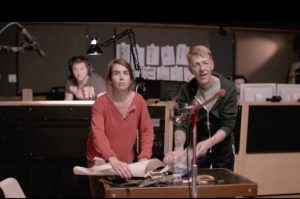UNDER CONSTRUCTION
Sound Systems
You will need a basic PA system in your drama room, to allow you to connect a laptop or MP3 player and provide a decent level of amplification. All-in-one units are available which can be easily moved around.
The system shown on the right is suitable for smaller rooms.
A laptop or MP3 player can connect to the system using a suitable ‘twin phono to minijack’ cable as shown on the far right, or your can connect via Bluetooth.
MORE INFORMATION TO FOLLOW
Using MP3 Players
As most students have portable MP3 players, consider how they might use their technology to make a recording suitable for an audio walk.
Software
Editing: Audacity
Editing / Creation: Logic Pro
Playback Control: QLab
QLab has evolved over the last few years to be the preferred software for cue-based playback of sound (i.e. sounds that are played on a particular cue). It runs on Apple Mac computers, and has a number of invaluable features:
- Each sound file, by default, plays once and then stops.
- Sounds can play simultaneously, allowing montages or soundscapes to be built up, on cue.
- Cues can be used to start a sound, to fade it in, to fade it out, or just to change volume.
- Complex sequences of fades can be automated to run exactly the same every performance
- Fades and cues can be set to run at specific times after another cue starts, or on a single press of the space bar.
- The basic version, allowing you to play sounds through a single stereo output (e.g. the headphone socket of the Mac) is free of charge.
- The software can be upgraded allowing you to play through multiple outputs, and also to play video files. The necessary licence can be purchased in full, or can be rented for a few days at a time, at very reasonable prices.
- It’s the same software being used to run West End theatre shows.
- Every version brings out new features – live cameras (e.g. from webcam inputs) can be projected (and superimposed over other video files, live), and even complex show control setups can be built, with QLab controlling a modern lighting desk.
More about QLab: http://figure53.com/qlab/
COMING SOON – QLAB demonstration video
Soundscape Creation: Ableton
COMING SOON
Foley
The sounds you hear during a film or TV show may not be as they seem. Many are created after the actors have gone home by Foley Artists. The job of editing and enhancing the first sound films made at Universal Studios in Hollywood went to Jack Foley, a sound technician. He was so good at imitating the footstep patterns of the actors of the day that the process was named after him.
See Clip from The Secret World of Foley for some classroom-friendly examples.

While it applies primarily to film production, the term can also be used for creating sound effects for radio drama, or for multimedia productions like The Encounter by Complicite or some of the work of Katie Mitchell (see video below).
Using Foley
Use a cheap digital recorder (e.g. Zoom H1, shown right) and a set of headphones to record sounds made by everyday objects, then use software to distort them.
What happens if you make a short film and have the wrong sounds accompanying each action? How far from reality can you get and still believe that the action on screen sounds right?
Examples of Foley from popular films / TV shows
- Original Star Trek (1960s) – The door opening sound was a piece of paper being pulled from an envelope
- Fight scenes – A knife through flesh is probably a knife through frozen Romaine lettuce.
- Birds flapping – a pair of (non-woollen) gloves being shaken
- Crackling fire – Cellophane scrunched up
Sound Effects
Software such as Apple’s Logic Pro comes complete with a huge range of sound effects. You can also download them from various websites.
COMING SOON – LINKS
Music
Music can have a powerful effect at helping students find the emotion of a particular scene.
Experiment with using a piece of music under a scene, and ask the students to change their performance based on the tempo or volume of the music. A piece such as Nimrod from Elgar’s Enigma Variations or Symphony No. 3 by Saint-Saens has a suitable range. The students could then try repeating the scene using the same emotion, but without the music, or starting the music at a different point in the scene. You’ll have your own ideas about music that would work. Classical music works best, as the beat is not regular, and a piece should be chosen without lyrics.


